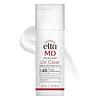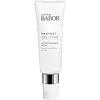What's inside
What's inside
 Key Ingredients
Key Ingredients

 Benefits
Benefits

 Concerns
Concerns

 Ingredients Side-by-side
Ingredients Side-by-side

Zinc Oxide 9%
Cosmetic ColorantEthylhexyl Methoxycinnamate 7.5%
UV AbsorberWater
Skin ConditioningCyclopentasiloxane
EmollientNiacinamide
SmoothingOctyldodecyl Neopentanoate
EmollientHydroxyethyl Acrylate/Sodium Acryloyldimethyl Taurate Copolymer
Emulsion StabilisingButylene Glycol
HumectantPhenoxyethanol
PreservativePolyisobutene
Triethoxycaprylylsilane
Tocopheryl Acetate
AntioxidantPEG-7 Trimethylolpropane Coconut Ether
EmulsifyingOleth-3 Phosphate
Iodopropynyl Butylcarbamate
PreservativeLactic Acid
BufferingSodium Hyaluronate
HumectantPhosphoric Acid
BufferingZinc Oxide 9%, Ethylhexyl Methoxycinnamate 7.5%, Water, Cyclopentasiloxane, Niacinamide, Octyldodecyl Neopentanoate, Hydroxyethyl Acrylate/Sodium Acryloyldimethyl Taurate Copolymer, Butylene Glycol, Phenoxyethanol, Polyisobutene, Triethoxycaprylylsilane, Tocopheryl Acetate, PEG-7 Trimethylolpropane Coconut Ether, Oleth-3 Phosphate, Iodopropynyl Butylcarbamate, Lactic Acid, Sodium Hyaluronate, Phosphoric Acid
Water
Skin ConditioningEthylhexyl Methoxycinnamate
UV AbsorberDiethylamino Hydroxybenzoyl Hexyl Benzoate
UV FilterEthylhexyl Triazone
UV AbsorberDibutyl Adipate
EmollientGlycerin
HumectantMethyl Methacrylate Crosspolymer
Phenylbenzimidazole Sulfonic Acid
UV AbsorberBis-Ethylhexyloxyphenol Methoxyphenyl Triazine
Skin ConditioningArginine
MaskingUndecane
EmollientLauryl Glucoside
CleansingPolyglyceryl-2 Dipolyhydroxystearate
Skin ConditioningTridecane
PerfumingAluminum Starch Octenylsuccinate
AbsorbentTocopheryl Acetate
AntioxidantDimethicone
EmollientPanthenol
Skin ConditioningPhenoxyethanol
PreservativeMaltodextrin
AbsorbentXanthan Gum
EmulsifyingButylene Glycol
HumectantMethylparaben
PreservativeEthylparaben
PreservativeDisodium EDTA
Propylene Glycol
HumectantPentylene Glycol
Skin ConditioningCassia Alata Leaf Extract
AstringentCitric Acid
BufferingCaesalpinia Spinosa Fruit Extract
Skin ProtectingCaprylic/Capric Triglyceride
MaskingSodium Carboxymethyl Beta-Glucan
CleansingTocopherol
AntioxidantAscorbyl Tetraisopalmitate
AntioxidantBiosaccharide Gum-4
Skin ConditioningHelianthus Annuus Sprout Extract
Skin ConditioningPantolactone
HumectantCarbomer
Emulsion StabilisingHelianthus Annuus Seed Oil
EmollientDna
Skin ConditioningWater, Ethylhexyl Methoxycinnamate, Diethylamino Hydroxybenzoyl Hexyl Benzoate, Ethylhexyl Triazone, Dibutyl Adipate, Glycerin, Methyl Methacrylate Crosspolymer, Phenylbenzimidazole Sulfonic Acid, Bis-Ethylhexyloxyphenol Methoxyphenyl Triazine, Arginine, Undecane, Lauryl Glucoside, Polyglyceryl-2 Dipolyhydroxystearate, Tridecane, Aluminum Starch Octenylsuccinate, Tocopheryl Acetate, Dimethicone, Panthenol, Phenoxyethanol, Maltodextrin, Xanthan Gum, Butylene Glycol, Methylparaben, Ethylparaben, Disodium EDTA, Propylene Glycol, Pentylene Glycol, Cassia Alata Leaf Extract, Citric Acid, Caesalpinia Spinosa Fruit Extract, Caprylic/Capric Triglyceride, Sodium Carboxymethyl Beta-Glucan, Tocopherol, Ascorbyl Tetraisopalmitate, Biosaccharide Gum-4, Helianthus Annuus Sprout Extract, Pantolactone, Carbomer, Helianthus Annuus Seed Oil, Dna
 Reviews
Reviews

Ingredients Explained
These ingredients are found in both products.
Ingredients higher up in an ingredient list are typically present in a larger amount.
Butylene Glycol (or BG) is used within cosmetic products for a few different reasons:
Overall, Butylene Glycol is a safe and well-rounded ingredient that works well with other ingredients.
Though this ingredient works well with most skin types, some people with sensitive skin may experience a reaction such as allergic rashes, closed comedones, or itchiness.
Learn more about Butylene GlycolEthylhexyl Methoxycinnamate is an organic compound that provides UVB protection. It often goes by the more common name of octinoxate. It is created from methoxycinnamic acid and 2-ethylhexanol.
Ethylhexyl Methoxycinnamate absorbs UVB rays with wavelengths between 280-320 nm. UV absorbers protect your skin by using chemical reactions to convert UV rays into heat and energy.
UVB (290-320 nm) rays emit more energy than UVA rays. They are capable of damaging DNA, causing sunburns and are thought to be linked to skin cancer.
The state of Hawaii has banned sunscreens containing octinoxate due to its potential impact on coral reefs. More research is needed to bridge gaps in this research. The European Union allows higher levels of octinoxate in sunscreens than the US and Australia.
Ethylhexyl Methoxycinnamate is oil soluble. It is not stable and may lose efficacy when exposed to sunlight.
Learn more about Ethylhexyl MethoxycinnamatePhenoxyethanol is a preservative that has germicide, antimicrobial, and aromatic properties. Studies show that phenoxyethanol can prevent microbial growth. By itself, it has a scent that is similar to that of a rose.
It's often used in formulations along with Caprylyl Glycol to preserve the shelf life of products.
Tocopheryl Acetate is AKA Vitamin E. It is an antioxidant and protects your skin from free radicals. Free radicals damage the skin by breaking down collagen.
One study found using Tocopheryl Acetate with Vitamin C decreased the number of sunburned cells.
Tocopheryl Acetate is commonly found in both skincare and dietary supplements.
Learn more about Tocopheryl AcetateWater. It's the most common cosmetic ingredient of all. You'll usually see it at the top of ingredient lists, meaning that it makes up the largest part of the product.
So why is it so popular? Water most often acts as a solvent - this means that it helps dissolve other ingredients into the formulation.
You'll also recognize water as that liquid we all need to stay alive. If you see this, drink a glass of water. Stay hydrated!
Learn more about Water